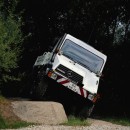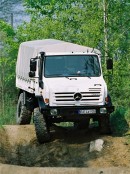← Continued from Page 1 of "Unimog, 60 Years of an Ugly, Extreme Machine"MODELS
Because it is such a versatile machine, the Unimog has probably more versions and variants that all of its competitors combined. When the range started its life, however, it did so without any actual model ranges. The first actual production series, the 406, or medium-duty series, came to life in 1963. The decision to create a new range of vehicles was made after Daimler found out that the models still mainly used by the military had little to do with civilian requirements.
The first civilian-aimed model was powered by a large-volume OM 312 six-cylinder diesel engine with a displacement of 5.7l. The success of the new line was huge, and allowed Daimler to produce, by the end of 1966, the 100,000th Unimog.
The 406 was followed in 1972 by the MB-trac, the tractor variant of the series. Having a machine that featured all-wheel drive and power transmission to four equal-sized wheels proved, however, not to be desirable traits, as the market did not respond to the model all that well. After trying to make the series work in a joint venture with the agricultural machinery unit of Deutz, Daimler discontinued the MB-trac line in 1991.
In 1974 the U 120, the heavy-duty series, came to life. The medium-duty series was expanded in 1985 and 1985 with the 407 - 437 series and 408/418 series, respectively. The beginning of the new millennium brought with it the U 300 – U 500 Unimog generation.
Now, Unimogs of various shapes and sizes are used to perform all type of tasks. The goal Mercedes has set for the future of these machines is to move them from the streets and highways into the cities, where they can be used by city authorities and fleet operators.
The new Unimogs envisioned by Mercedes are equipped with permanent all-wheel drive, electro-pneumatic Telligent gearshift, the new VarioPower high-performance hydraulic system and new engines.
The first civilian-aimed model was powered by a large-volume OM 312 six-cylinder diesel engine with a displacement of 5.7l. The success of the new line was huge, and allowed Daimler to produce, by the end of 1966, the 100,000th Unimog.
The 406 was followed in 1972 by the MB-trac, the tractor variant of the series. Having a machine that featured all-wheel drive and power transmission to four equal-sized wheels proved, however, not to be desirable traits, as the market did not respond to the model all that well. After trying to make the series work in a joint venture with the agricultural machinery unit of Deutz, Daimler discontinued the MB-trac line in 1991.
In 1974 the U 120, the heavy-duty series, came to life. The medium-duty series was expanded in 1985 and 1985 with the 407 - 437 series and 408/418 series, respectively. The beginning of the new millennium brought with it the U 300 – U 500 Unimog generation.
Now, Unimogs of various shapes and sizes are used to perform all type of tasks. The goal Mercedes has set for the future of these machines is to move them from the streets and highways into the cities, where they can be used by city authorities and fleet operators.
The new Unimogs envisioned by Mercedes are equipped with permanent all-wheel drive, electro-pneumatic Telligent gearshift, the new VarioPower high-performance hydraulic system and new engines.










